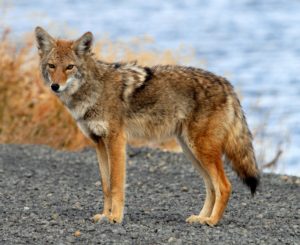(Excerpts below are from an article on coyotes entitled, “A Place for Coyote” which was authored by Retzer volunteer naturalist Maureen Patton-Gross and first appeared 30 years ago in the Mar/Apr 1987 “Center Line” issue. In the article, she clearly distinguished coyotes from other canids based on their size, color, tail, voice, tracks, and scat.)
Evidence of coyotes living in southeastern Wisconsin has been mounting steadily, which logically leads to the question of why the coyote has returned to this area after an apparent long absence. In order to address this issue, the coyote’s needs must be analyzed.
 As with other kinds of wildlife, the coyote depends on three basic requirements from the environment. These requirements are water, shelter, and food. The coyote is often associated with arid regions of the West, and has learned very cunning ways to find water in these marginal areas. However, water sources have never been in short supply here. The glaciers left us many lakes, rivers, springs, kettle ponds, and various kinds of wetlands.
As with other kinds of wildlife, the coyote depends on three basic requirements from the environment. These requirements are water, shelter, and food. The coyote is often associated with arid regions of the West, and has learned very cunning ways to find water in these marginal areas. However, water sources have never been in short supply here. The glaciers left us many lakes, rivers, springs, kettle ponds, and various kinds of wetlands.
Shelter has been a more pronounced problem for the coyote here. In the past when only Native Americans lived here, southeastern Wisconsin was a region where the tall grass prairie met the hardwood forests. This environment supported much wildlife, including both the coyote and timber wolf. The indigenous people of the past lived side by side with the wild canids without conflict. They were intimately familiar with coyote behavior and habits. The ways of the coyote were often woven into their folklore and mythology. The coyote was well respected by Native Americans for his cunning, speed, and intelligence.
When Europeans arrived on the scene, drastic changes took place. The tall grass prairie was viewed as tillable, fertile farmland, and the hardwood forest was viewed as the enemy to be cleared with much labor and sweat. Eventually the landscape changed into a monotonous repetition of farmsteads all with large fields of similar crops. As a result, there was little shelter left for coyotes or prey species. Not only did the European change the landscape, he also referred to the coyote and the timber wolf as “ravenous beasts” which attacked his livestock. Because of this attitude, bounties were established. “Wolf” hunts became a favorite social sport. Unregulated hunting and trapping were the rule. By the turn of the century, southeastern Wisconsin was devoid of much of its former wildlife.
However, as time went on, the landscape again began to change. Residents began to realize the decline in wildlife and recreational land. This resulted in a demand for public land and hunting regulations. Bounties were slowly abolished. Farming practices changed also. The government encouraged farmers to grow wind breaks, to take some fields out of crop production, and to leave erodible land untilled. In addition, some farms were abandoned due to financial stress. The result of these activities has been the creation of thousands of acres of old field and brush habitat ideally suited to the coyote.
This old field and brush habitat also provided shelter for prey species, which leads to the discussion of coyote food requirements. Because small mammals are the mainstay of the coyote, this canid is a predator. The coyote, though, is also an omnivore (eating both plants and animals). The coyote is an opportunist, and this adaptable canid will eat fallen apples or spilled corn from harvest operations. This animal is not a finicky eater, and will eat anything from leather straps and wool rugs to crayfish, pigeons, and deer. Coyote impact on deer is minimal, however, because the canid is not as powerful or as socially organized as the timber wolf. The coyote has few opportunities to kill large game without risking injury or death. While the timber wolf specializes in large mammals, the coyote specializes in small mammals. High on the list of coyote preferences are woodchucks, rabbits and mice of all kinds. Because of these food preferences, the coyote is very beneficial to the crop farmer.
It is evident that at least some sections of the local environment support the coyote well with the basic requirements of water, shelter, and food. The most ideal situation for a coyote is an area where several different ecosystems merge. For example, looking out over the high hills at Retzer Nature Center, a mosaic of woodlots, old fields, prairies, croplands, wetlands, and streams can be seen. Such diversity provides a habitat rich in large populations of small mammal species. This in turn provides the coyote with a dynamic yet stable food base while also providing the coyote with cover from his primary predator – man.
To the biologist, the coyote is an indicator of a varied and healthy environment. Presently most residents seem to have a curious, neutral, or favorable attitude toward the coyote. It is these very attitudes toward this canid and toward regional land use that will ultimately determine the future status of the coyote.

